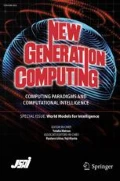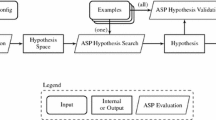Abstract
Hypotheses constructed by inductive logic programming (ILP) systems are finite sets of definite clauses. Top-down ILP systems usually adopt the following greedy clause-at-a-time strategy to construct such a hypothesis: start with the empty set of clauses and repeatedly add the clause that most improves the quality of the set. This paper formulates and analyses an alternative method for constructing hypotheses. The method, calledcautious induction, consists of a first stage, which finds a finite set of candidate clauses, and a second stage, which selects a finite subset of these clauses to form a hypothesis. By using a less greedy method in the second stage, cautious induction can find hypotheses of higher quality than can be found with a clause-at-a-time algorithm. We have implemented a top-down, cautious ILP system called CILS. This paper presents CILS and compares it to Progol, a top-down clause-at-a-time ILP system. The sizes of the search spaces confronted by the two systems are analysed and an experiment examines their performance on a series of mutagenesis learning problems.
Similar content being viewed by others
References
Cormen, T. H., Leiserson, C. E. and Rivest, R. L.,Introduction to Algorithms, MIT Press, 1990.
De Raedt, L. and Dehaspe, L., “Clausal Discovery,”Technical Report CW 238, Department of Computing Science, K. U. Leuven, 1996.
Dietterich, T. G., “Statistical Tests for Comparing Machine Learning Algorithms,” to appear inNeural Computation, 1998.
Muggleton, S., “Inverse Entailment and Progol,”New Generation Computing 13, pp. 245–286, 1995.
Muggleton, S. and De Raedt, L., “Inductive Logic Programming — Theory and Methods,”Journal of Logic Programming 19–20, pp. 629–679, 1994.
Quinlan, J. R., “Learning Logical Definitions from Relations,”Machine Learning 5, pp. 239–266, 1990.
Srinivasan, A., Muggleton, S., Sternberg, M. J. E. and King, R. D., “Comparing the Use of Background Knowledge by Inductive Logic Programming Systems,”Technical Report PRG-TR-9-95, Oxford University Computing Laboratory, 1995.
Author information
Authors and Affiliations
Corresponding author
Additional information
Simon Anthony, BEng.: Simon, perhaps better known as “Mr. Cautious” in Inductive Logic Programming (ILP) circles, completed a BEng in Information Engineering at the University of York in 1995. He remained at York as a research student in the Intelligent Systems Group. Concentrating on ILP, his research interests are Cautious Induction and developing number handling techniques using Constraint Logic Programming.
Alan M. Frisch, Ph.D.: He is the Reader in Intelligent Systems at the University of York (UK), and he heads the Intelligent Systems Group in the Department of Computer Science. He was awarded a Ph. D. in Computer Science from the University of Rochester (USA) in 1986 and has held faculty positions at the University of Sussex (UK) and the University of Illinois at Urbana-Champaign (USA). For over 15 years Dr. Frisch has been conducting research on a wide range of topics in the area of automated reasoning, including knowledge retrieval, probabilistic inference, constraint solving, parsing as deduction, inductive logic programming and the integration of constraint solvers into automated deduction systems.
About this article
Cite this article
Anthony, S., Frisch, A.M. Cautious induction: An alternative to clause-at-a-time hypothesis construction in inductive logic programming. New Gener Comput 17, 25–52 (1999). https://doi.org/10.1007/BF03037581
Received:
Revised:
Issue Date:
DOI: https://doi.org/10.1007/BF03037581




